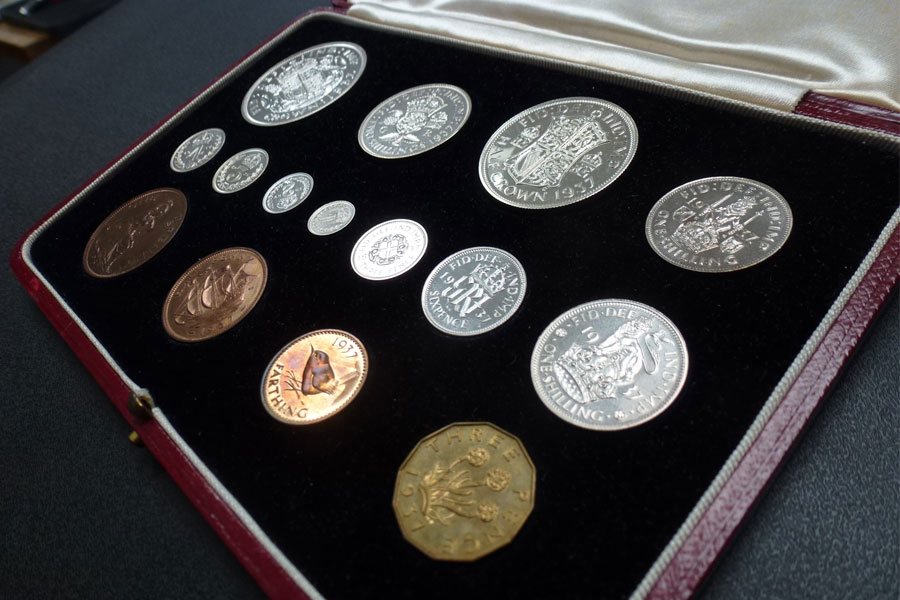The value of a coin is usually dependent on two main factors. The first is scarcity and the second is condition. Scarcity is quite easy to understand and appreciate. Clearly a coin where only 10,000 exist is going to be a lot scarcer than a coin which had 10 million minted. Other more subtle factors come into play here as well, such as popularity. A coin from the UK will have a much greater following than a coin from Papua New Guinea simply because there are more collectors of UK coins. A UK coin with a mintage of 10,000 will be more valuable than a Papua New Guinea coin with a similar mintage because of the important adage of supply and demand.
The scarcity factor however is further complicated by condition and what we call the survival rate. As we have said before, any coin with a low mintage number is going to be scarce, but on many occasions a coin can be deemed scarce because it is scarce in a high-quality grade. Considering that most coins that have ever existed were produced purely for circulating amongst the population to facilitate the purchase of goods and general trade, then the large majority of coins will over time show considerable wear and tear. Goodness knows how many hands coins pass through in their lifetime. They jingle about in our pockets, they get dropped on the floor, they are constantly rubbing against other coins, getting scratched and worn. If we take the humble Victorian Penny, let’s say the 1862 issue, there were over 50 million minted in that year alone. We can therefore class this coin as common. However, the vast majority will show various stages of wear meaning that the poorest examples will only be worth about £1. If however you were to find one that is virtually uncirculated – so pretty much as it was when it first came from the Mint, then the price rises to £200 – not bad for a “common” coin but clearly to find a coin that has survived 160 years old still in perfect condition is very unusual. It is a similar situation to buying a Corgi model car in the 1950’s. How many kids would have kept the car untouched in its original box and left it there for 70 years? Obviously not many, just the same as someone finding a brand-new shiny Penny in 1862 and thinking to themselves, I will keep that and not spend it and hopefully it will be worth something someday.
Therefore the second factor, condition – the assessment of which is termed grading, is vitally important whether we are talking about a scarce coin, or a more common coin which has a low survival rate in a high grade. For the large majority of collectors and dealers in the UK they tend to use the British system of grading. The United States and some other countries use their own methods, but we certainly stick to the tried and tested UK standards.
We have listed below the main grades or states of condition that you can use for coins issued since the late 1700’s. Before that coins were Hammered and because of their age and more crude appearance, such a wide variety of grades are not required so often.
UNC: Uncirculated: As it implies – a coin which has not been in circulation. Pretty much as good as you can get – the highest grade. May not be completely 100% perfect, as coins can pick up the odd scratch or “bag mark” due to contact with other coins during the minting process.
EF: Extremely Fine: A coin which has had minimal circulation, in fact could almost appear as virtually Uncirculated but with slight wear on the highest areas of relief and a few scratches/marks showing under magnification.
VF: Very Fine: A coin which has seen little use but starting to show more wear on the highest areas. Still shows a great amount of detail and considered an attractive example from the collector’s viewpoint.
F: Fine: Coins in this grade show considerable wear on all raised surfaces but with some details still visible.
FAIR: A heavily worn coin but still identifiable with readable date and legends.
POOR: A very worn coin only just recognisable. Coins in this grade will only be worth the scrap metal value unless they are incredibly rare.
As perhaps you can see from these descriptions there are many general terms being described which will always be open to different interpretations leading to varying opinions on values. It does take many years of experience examining coins and comparing the different grades to fully appreciate the condition scale detailed above. We must stress that this is a guide and really to find out a true professional opinion on both condition and value then please contact us at webuycoins.
